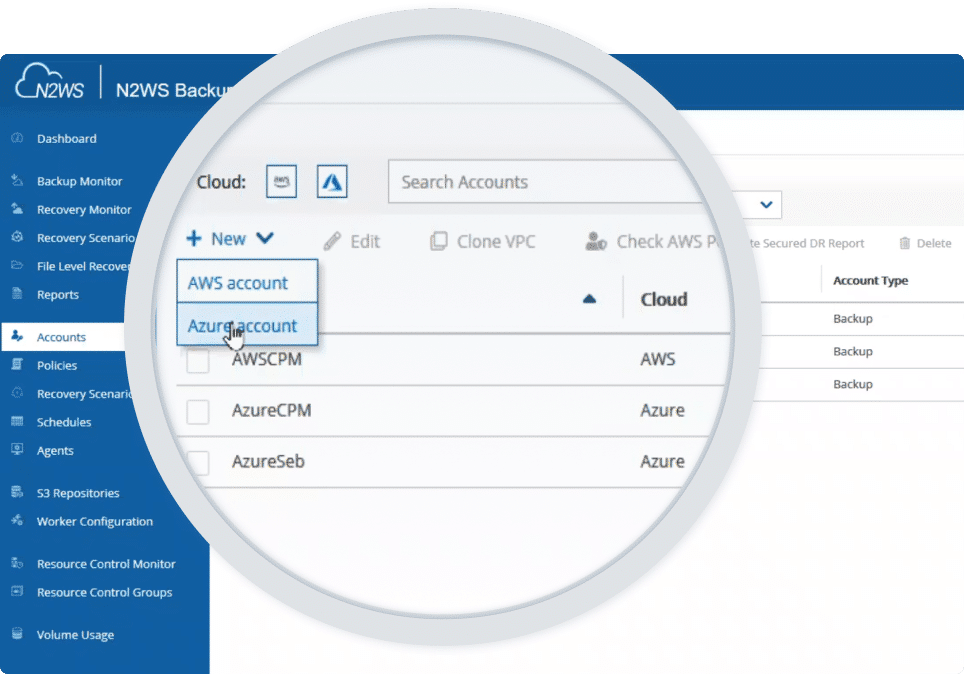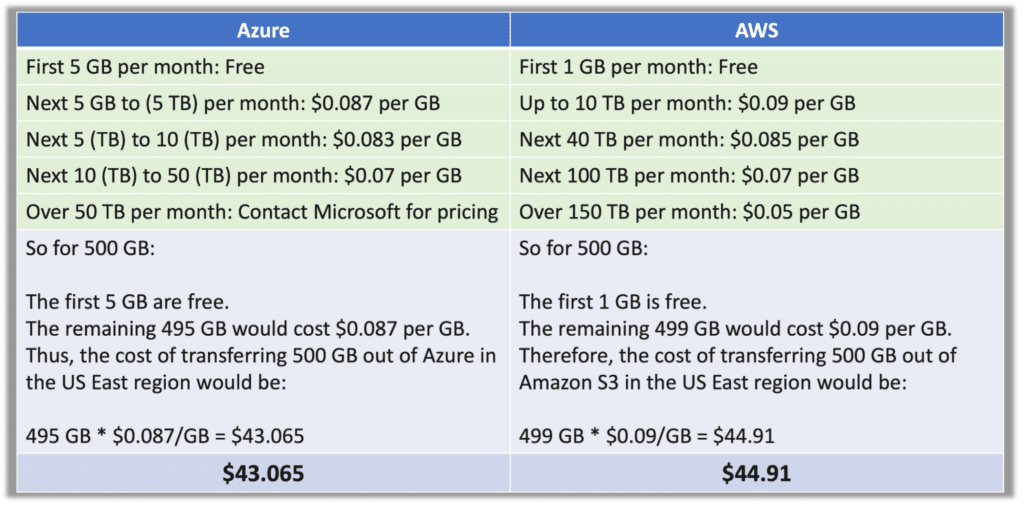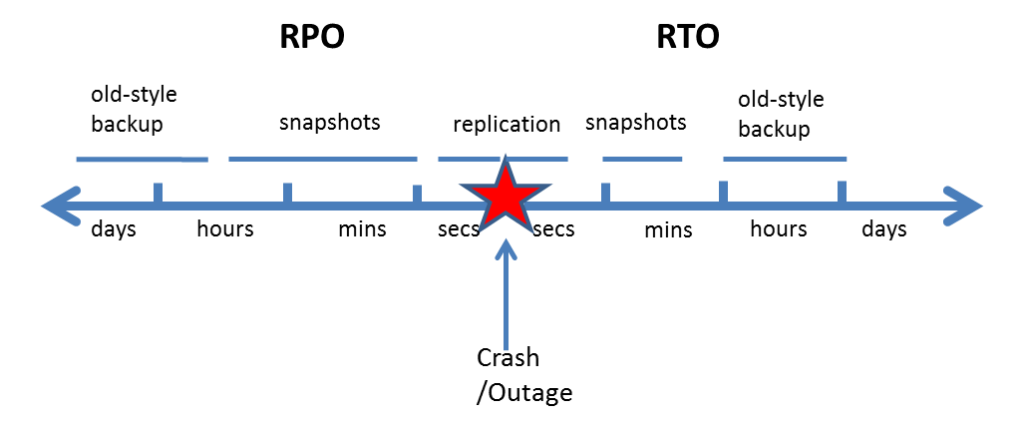Introduction
The transition from on-premises (on-prem) to cloud-based backup solutions is not just a growing trend —it’s the future norm and a business necessity. As data becomes increasingly complex and interconnected, the need for cloud automation and cross-cloud capabilities is higher than ever.
Cloud backup —a crucial element of cloud computing— involves securely storing data in cloud-based infrastructure. This practice ensures the availability, integrity, and recovery of data. In this blog post, we’ll explore the current state of cloud backup, the growing demand for cross-cloud solutions, and how N2WS plays a pivotal role in shaping the future of cloud computing.
What Does the Current State of the Cloud Look Like?
The Switch from On-Premises to Cloud-Based Backup
The shift from on-prem storage to cloud-based backup solutions represents a significant transformation in modern IT infrastructure. Cloud backup offers several benefits, as it enables businesses to operate more effectively and adapt to their ever-changing business landscape.
Advantages that the Cloud Brings
- Scalability: Cloud backup solutions offer unparalleled scalability and allow organizations to scale their storage resources up or down as needed. This eliminates the constraints imposed by physical infrastructure. A notable example of scalability in action is Netflix’s transition to the cloud. By moving their video streaming services to Amazon Web Services (AWS), Netflix was able to dynamically scale their infrastructure to meet spikes in demand, ensuring uninterrupted streaming for their over 238 million subscribers worldwide.
- Flexibility: Cloud backup is inherently flexible. It accommodates changes in data volume, access patterns, and compliance requirements with ease.
- Cost Efficiency: Transitioning to the cloud reduces the capital expenditures associated with on-prem storage. The shift from a capital expense (CapEx) model to an operational expense (OpEx) model allows organizations to allocate resources more efficiently. ·
- Global Accessibility: Cloud backup solutions provide global accessibility to data and resources. Users can access their data from anywhere, facilitating collaboration among remote teams and enabling disaster recovery strategies.
The Growing Challenges of On-Premises
While on-prem storage has been a crucial component of IT infrastructure for decades, it is gradually being rendered obsolete for several compelling reasons:
- Capital Expenses: On-prem storage necessitates significant capital expenditures. Organizations have to invest in hardware, data centers, cooling systems, and infrastructure maintenance. This capital-intensive model can strain budgets and hinder innovation.
- Limited Scalability: Traditional on-prem solutions have limited capacity. Organizations need to accurately predict their storage requirements and invest in hardware accordingly. This can lead to underprovisioning, resulting in resource contention and poor performance. Contrast this with cloud-based solutions that offer elasticity, which allows companies to expand their operations without constraints.
- Maintenance Overhead: On-prem infrastructure demands ongoing maintenance. IT teams need to perform hardware upgrades, apply firmware patches, and manage physical security. This maintenance overhead diverts IT resources away from strategic initiatives, hindering innovation.
- Lack of Redundancy: On-prem backup solutions lack the inherent redundancy and geographic dispersion provided by cloud solutions. In the event of disasters, data stored on-premises is vulnerable to loss.
The transition from on-premises to cloud-based backup solutions offers many advantages, including scalability, flexibility, cost efficiency, and global accessibility. On-prem storage seems outdated to many people due to its capital expenses, limited scalability, and lack of redundancy. The cloud not only addresses these challenges, but also paves the way for a more agile, cost-effective, and resilient IT environment.
Fortify your cloud across every critical dimension.
- Efficiency + Optimization
- Security + Control
- Orchestration + Visibility

Cross-Cloud Capabilities: Shaping the Future of Cloud Computing
The rapid evolution of the cloud computing landscape has resulted in the emergence of cross-cloud capabilities. This transformation is responsible for solving the challenges posed by using multiple cloud providers and for the rising demand of flexibility, cost-effectiveness, and high availability in cloud infrastructure.
What is it that is triggering an increase in demand for multi-cloud storage solutions? There can be strategic advantages of leveraging diverse cloud providers, but this has been plagued by complexity and cost challenges.
Escalating Demand for Multi-Cloud Storage Solutions
The market for multi-cloud storage solutions is experiencing a significant surge, as it enables organizations to optimize their infrastructure and avoid vendor lock-in by leveraging the unique strengths of different cloud providers.
Why Multi-Cloud Storage Solutions are in High Demand
- Flexibility: Multi-cloud storage solutions provide organizations with the flexibility to select the best-suited cloud services from various cloud service providers. This flexibility enables organizations to swiftly adjust to changing demands and industry trends.
- Cost Optimization: Organizations can effectively optimize cloud costs by distributing workloads across cloud providers. This approach prevents over-reliance on a single vendor and offers the freedom to choose cost-effective solutions for specific tasks.
- Enhanced Performance: Utilizing the strengths of multiple cloud service providers enables businesses to enhance their overall performance. For example, an organization may use a cloud provider known for AI capabilities to enhance data analytics while relying on another for its robust data storage offerings.
Relying on a single cloud provider is sometimes not enough to satisfy all of your team’s requirements. Employing multiple cloud providers can open you up to more service options and negotiating power with your other cloud providers.
Strategic Advantages of Leveraging Diverse Cloud Providers
Cross-cloud capabilities enable organizations to effectively opt for cloud services that meet their unique requirements, leading to a variety of benefits:
Optimizing Cloud Infrastructure and Avoiding Vendor Lock-In
Businesses can avoid excessive reliance on a single vendor by distributing workloads across cloud providers. This strategy reduces the risk of vendor-specific issues and guarantees the freedom to select the most cost-effective solutions.
We’ve all heard about the stories of Netflix employing a multi-cloud strategy that uses both AWS and Google Cloud. This allows Netflix to optimize cloud costs and avoid vendor lock-in because they have the ability to select the cloud services that best meet their specific needs based on data-driven decisions.
Enhancing Redundancy for Superior Availability
Cross-cloud strategies significantly enhance redundancy, resulting in higher availability and robust disaster recovery capabilities. In the event of a cloud provider outage, businesses can seamlessly transition to an alternative cloud provider, in turn minimizing downtime and data loss.
Vast Improvement to Disaster Recovery Protection
With cross-cloud capabilities in place, the probability of multiple cloud providers experiencing simultaneous disasters becomes highly unlikely. This fundamental shift ensures business continuity and mitigates the risk of data loss, even in the face of unforeseen disruptions.

In the image above, you can see that N2WS gives you the option to create policies for both your AWS and Azure accounts, thus providing cross-cloud data lifecycle management for all of your N2WS protected resources.
🧐 Learn more about N2WS Cross-Cloud Capabilities in this blog post.
Unlikely Multiple Cloud Providers Suffer the Same Disaster
It is unlikely that multiple cloud providers will simultaneously experience the same disaster. This is due to the fact that cloud providers’ data centers are located in diverse geographic regions. This geographic dispersion helps to protect data from natural disasters and other catastrophic events.
This is also valuable in the case of an account compromise where you have to perform a significant recovery. Because your AWS resources also contain metadata and configuration details, you can do a full VPC and up recovery right from an Azure target. N2WS simplifies this process with our VPC Capture & Clone feature, which allows you to copy your VPC configurations to any other AWS region with an identical infrastructure setup.
The Crucial Role of Containers in Enabling Cross-Cloud Capabilities
Containers play a pivotal role in enabling cross-cloud capabilities by abstracting the underlying infrastructure. They allow organizations to deploy workloads across multiple cloud environments without concerns of compatibility issues. Each container operates independently of the host operating system, ensuring portability and consistency.
How Containers Simplify Cross-Cloud Deployments
Containers abstract the intricacies of the underlying infrastructure, allowing applications to run uniformly across multiple cloud providers. This abstraction simplifies deployment, management, and migration, which ultimately reduces operational complexity.
As an example, companies like Shopify utilize containers to enable cross-cloud deployments across AWS, Google Cloud, and Azure. This approach streamlines their development and deployment processes, ensuring a consistent experience for their merchant customers, regardless of the underlying cloud infrastructure.
Cross-cloud capabilities are reshaping the future of cloud computing that is driven by the need for flexibility, cost optimization, and high availability. Multi-cloud storage solutions empower organizations to leverage diverse cloud providers strategically. Containers, exemplified by their role in Kubernetes and real-world implementations, are instrumental in simplifying cross-cloud deployments. They ensure compatibility and reduce operational complexity.
Some Exciting Innovations Within N2WS
You likely run a cloud environment that is similar to what we’ve explored here so far. We’ve been listening to customers who are raising their requirements for enhanced data protection and disaster recovery. Cross-cloud and multi-cloud options are very much top of mind for many of today’s organizations.
Here are a few new N2WS features that are aimed at solving these challenges.
Putting AWS Backups into Azure Cold Storage for Cost Savings
N2WS Is Built with Simplicity and Cost Optimization in Mind
It’s easy to recognize the importance of flexibility and cost efficiency in cloud backup solutions. Cross-cloud recovery without the surprise of an oppressive cloud bill is the ultimate goal. Adding Azure as a backup target allows organizations to archive their AWS backups directly into Azure cold storage. This integration unlocks several advantages, with cost savings being a standout benefit.

When considering the cost of data retrieval, Azure offers competitive pricing compared to AWS. For instance, egress charges for restoring 500 GB in the U.S. East Region in Azure is approximately $43.07 compared to $44.91 in AWS. While this may seem like a small difference for a single operation, these savings can add up to a significant amount in the long run.
Enhanced Data Protection through Immutability
Beyond cost savings, N2WS enhances data protection through immutability. Immutability ensures that once data is archived, it cannot be deleted or modified, even intentionally. This additional security layer shields critical data from human error, cyber threats, or regional outages.
This is Only the Beginning
N2WS is committed to continuous innovation and expanding its cross-cloud capabilities. While it currently facilitates cross-cloud backup between AWS and Azure, the company has ambitious plans for the future, rendering it a forward-looking solution in the realm of cloud backup.
Realizing Further Cross-Cloud Abilities Between AWS and Azure
N2WS is actively developing new capabilities that will enable organizations to store Azure backups directly in AWS cloud storage. This expansion of functionality provides even greater flexibility and redundancy for cross-cloud backup solutions.
With the ability to seamlessly transfer data between the two largest cloud providers, organizations can further optimize their cloud infrastructure and enhance their disaster recovery strategies.
The Future of Cloud: Embracing the Multi-Cloud Trend
Recognizing the growing trend of multi-cloud adoption, N2WS is committed to extending its services beyond AWS and Azure. This will allow organizations that are adopting multi-cloud strategies to have access to comprehensive cross-cloud backup and data protection solutions.
Consider a scenario where a global enterprise uses AWS for its core computing needs, Azure for AI and machine learning, and GCP for data analytics. N2WS’ future expansion into GCP would provide this organization with a unified cross-cloud backup solution, streamlining data management and ensuring high availability across its multi-cloud infrastructure.
N2WS sets the stage for the future of cloud backup with its approach to cross-cloud capabilities. By offering archival of AWS backups into Azure cold storage, the solution addresses cost savings and data protection needs. Moreover, N2WS’ ambitious plans for further cross-cloud abilities and extension into other cloud providers like GCP highlight its commitment to delivering comprehensive cross-cloud backup capabilities for organizations of any size.
The Imperative Need for Automation in Cloud Backup
In the era of multi-cloud environments, the demand for automation in cloud backup solutions has become vital. Let’s delve into the significance of adopting a cloud-native backup solution, the pivotal role automation plays in ensuring efficient cloud backup, and how N2WS stands out with its strong cloud automation capacities compared to other tools like AWS Backup.
The Importance of Having a Cloud-Native Backup Solution
As organizations navigate the intricacies of multi-cloud environments, the adoption of a cloud-native backup solution becomes paramount. Cloud-native solutions are purpose-built to seamlessly integrate with cloud services for optimal performance, compatibility, and data protection.
Cloud-native solutions go beyond traditional data backup. They empower organizations to protect critical infrastructure configurations, networking details, and other essential components of their cloud environment.
This holistic approach safeguards the entire ecosystem, reducing vulnerability to disruptions.
The Power of Automation in Cloud Backup
Automation is a cornerstone of efficient cloud backup operations. Automated processes ensure that data is regularly backed up, swiftly recovered in the event of system failure, and managed throughout its lifecycle. Additionally, automation optimizes cloud costs by facilitating data tiering and efficient cloud storage management.
Challenges with Manual Backup
While AWS Backup is a widely adopted solution, it often necessitates significant manual intervention for backup and recovery tasks. Users frequently find themselves navigating complex interfaces to locate specific backups, a process that can be time-consuming and prone to errors.
For organizations with extensive cloud infrastructures, manually locating and restoring backups in AWS Backup can be cumbersome. This challenge underscores the need for automated solutions to streamline these critical processes.
Automation, Optimization, and Remote Recovery with N2WS
Since we’ve covered a lot of the challenges associated with backups in a multi-cloud environment, here are four targeted features that are designed to help with multi-cloud and cross-cloud configurations.
1) Backup and Recover AWS Resources Using a Microsoft Azure Target
You can protect your AWS resources while using Azure Blob storage as a backup target. This offers cost benefits and protection against localized issues in your AWS environment. Simply select an Azure target and restore it to any other available region in AWS, all with the click of a button.
2) 1-Click Cross-Account and Cross-Region Disaster Recovery
N2WS offers one-click cross-account and cross-region disaster recovery. This feature hastens the restoration of mission-critical workloads, reducing recovery time objectives (RTOs) and ensuring business continuity during disruptions.

3) Orchestrated Recovery Scenarios and Disaster Recovery Drills
Organizations can proactively plan for disasters with N2WS by creating orchestrated recovery scenarios and conducting disaster recovery drills. This practice ensures readiness for any significant business disruptions, minimizing the impact of disasters on operations.
4) Automated Transfer of Snapshots to Colder Storage
N2WS automates the transfer of snapshots to colder storage with N2WS AnySnap Archiver™, optimizing cloud costs and providing long-term data retention. This guarantees that data is managed efficiently, with minimal manual intervention required.
Consider a rapidly growing e-commerce platform that relies on N2WS for backup and disaster recovery. As the platform expands across multiple cloud providers, N2WS cloud automation capacities scale seamlessly, ensuring data protection and business continuity without the need for extensive manual efforts.
Automation is not merely a convenience for multi-cloud backup; it is a necessity. Look to cloud-native solutions like N2WS that are designed to integrate with other cloud services and thus provide full protection beyond data backup.
N2WS’ robust automation capabilities, which include one-click disaster recovery, orchestrated recovery scenarios, and automated data lifecycle management, set a high standard for cloud backup efficiency when compared to manual-intensive solutions like AWS Backup. As businesses increasingly rely on cloud infrastructure, embracing automation in cloud backup will be essential for data integrity, business continuity, and cost optimization.
The future of cloud backup will be diverse
More businesses are adopting a multi-cloud approach, which means that cross-cloud capabilities and automation are now indispensable. Turning your multi-cloud environment into a strategic advantage requires you to have all of your cloud operations tuned accordingly.
Disaster recovery and data lifecycle management have become increasingly flexible in the coming multi-cloud world, but not without complexity. Make sure that you are balancing your operational processes with your cloud costs. Moreover, optimizing your storage using the best-price option should always be built into your platform choices.
As you embark on your cloud journey, remember that the future of cloud backup is bright, and N2WS is here to help. Stay agile, stay automated, and stay ahead in the dynamic landscape of cloud computing with N2WS. Start a free trial directly from AWS Marketplace.

Ezra is the Sr. Director of Alliances and Partners at N2WS with more than 10 years of experience. Ezra enjoys long bike rides, cultivating rare semi-succulents, and building complex aquatic ecosystems.